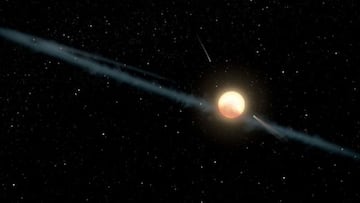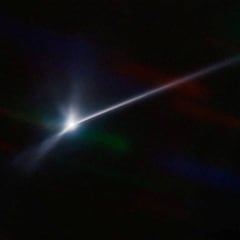When and where can you see the green comet from the United States?
NASA’s Jet Propulsion Laboratory predicts that a green comet will make its closest approach to Earth in February.


Yesterday comet C/2022 E3 (ZTF) was around 26 million miles from Earth, according to NASA. That is the closest this far-roaming ball of rock, dust and ice has come to our planet in the last 50,000 years. The last time C/2022 E3 (ZTF) paid a visit to this neck of the solar system was the start of the Upper Paleolithic age, when our species, homo sapiens, first started moving out of Africa and into Asia and Eurasia. And if our ancestors, looking up in wonder at the night sky, happened to glimpse this particular comet they might have noticed something rather remarkable about it: it’s green.
Newly-discovered green comet hasn't whizzed by Earth since the ice age. https://t.co/FYvWrezNlN pic.twitter.com/7NWa2MZxsP
— USA TODAY (@USATODAY) January 10, 2023
On this visit to the inner solar system C/2022 E3 (ZTF) will be being closely monitored by astronomers, who will be looking to study its key green colour in depth. The hue is likely caused by the presence of diatomic carbon. Due to a number of complex physical interactions the head of the comet appears green, but the tail doesn’t.
How and when to see the comet
The path of the comet has been tracked by NASA, allowing people to follow its progress. It has been visible in a few places already in january but february is the month that the comet will be much clearer in the sky, light pollution permitting.
- 5 February: Towards the star Capella in the Gemini constellation.
- 6 February: Look within Auriga, directly overhead at around 8 p.m. ET.
- 10 February: Look to the upper left of Mars
If you are living in a location with lots of light pollution then there is the option to follow the comet on YouTube.
How long has Nasa known about the comet?
NASA said in a press release that astronomers originally saw the comet in March 2022.
Moreover, NASA stated that comet C/2022 E3 (ZTF) might be “just barely visible to the eye in dark night sky” on 2 February. Comet brightness is “notoriously unpredictable,” according to the organization. A greenish coma, a wide dust tail, and a long, weak ion tail are all characteristics NASA cites for this comet.
In the Northern Hemisphere, the comet will be visible in the early morning sky using a telescope or binoculars throughout January, according to USA Today.
Related stories
According to NASA, the comet most likely originated in the solar system’s outermost area, the Oort Cloud, which NASA describes as a “big, thick-walled bubble made of frozen chunks of space debris the sizes of mountains and sometimes larger.”
Finally, the agency stated in a news release on 24 December that “the new long-period comet has brightened substantially and is now sweeping across the northern constellation Corona Borealis in predawn skies. It’s still too dim to see without a telescope though.”

